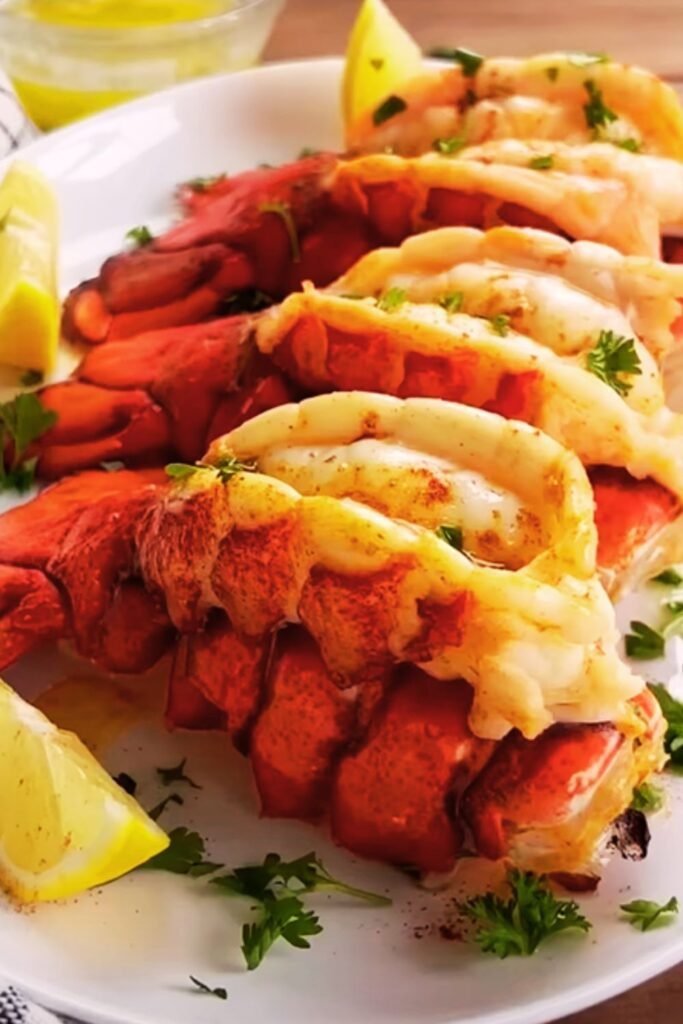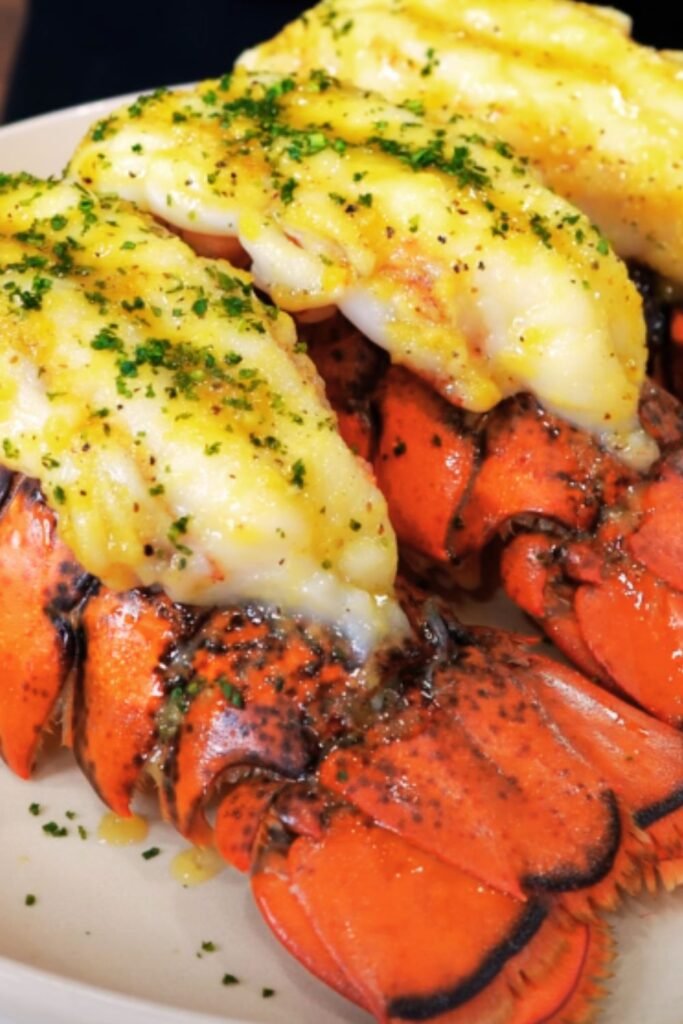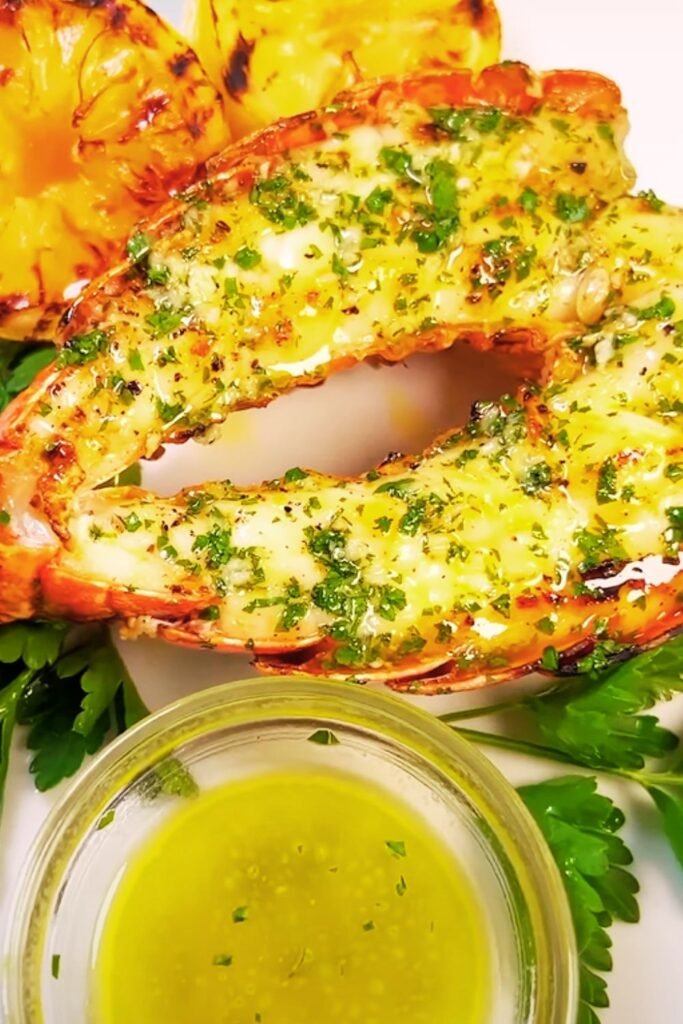When I first attempted to make baked lobster tails at home, I was intimidated by what seemed like an impossibly elegant dish. However, after years of perfecting my technique and experimenting with different butter combinations, I’ve discovered that creating restaurant-quality lobster tails in your own kitchen is not only achievable but surprisingly straightforward. This buttery baked lobster tail recipe has become my go-to method for impressing dinner guests and treating my family to something truly special.
The secret lies in understanding the delicate nature of lobster meat and how proper preparation, timing, and the right butter mixture can transform these crustacean treasures into a memorable culinary experience. I’ve refined this recipe through countless trials, and I’m excited to share every detail that will help you achieve perfect results every single time.
Understanding Lobster Tails
Before diving into the recipe, let me explain the key terms and concepts that will help you master this dish:
Cold Water Lobster Tails : These come from lobsters harvested in colder northern waters, particularly from Maine, Canada, and the North Atlantic. They have sweeter, more tender meat with a firmer texture.
Warm Water Lobster Tails : Sourced from warmer southern waters, including the Caribbean and Mediterranean. The meat tends to be slightly tougher and less sweet than cold water varieties.
Butterfly Cut : A preparation technique where the lobster tail is split lengthwise through the shell, allowing the meat to be lifted and placed on top of the shell for even cooking and presentation.
Compound Butter : A mixture of softened butter combined with herbs, spices, and other flavorings that’s used to enhance the natural sweetness of lobster meat.
Internal Temperature : The safe cooking temperature for lobster meat is 145°F (63°C), at which point the meat becomes opaque and firm but not rubbery.
Selecting the Perfect Lobster Tails
My experience has taught me that choosing the right lobster tails makes all the difference in the final result. I always look for tails that feel heavy for their size, with shells that have a vibrant color and no black spots or strong fishy odor. Fresh tails should have meat that springs back when gently pressed, and frozen tails should be completely frozen without any ice crystals or freezer burn.
I prefer cold water lobster tails for this recipe because their meat has a naturally sweeter flavor and more tender texture that pairs beautifully with butter. The ideal size range I’ve found is 6-8 ounces per tail, which provides substantial portions without being overwhelming.

Essential Equipment and Ingredients
Equipment Needed
- Sharp kitchen shears
- Baking sheet with raised edges
- Meat thermometer
- Small mixing bowl
- Pastry brush
- Aluminum foil
Core Ingredients
| Ingredient | Quantity | Purpose | Quality Notes |
|---|---|---|---|
| Lobster tails | 4 (6-8 oz each) | Main protein | Cold water preferred, fresh or properly thawed |
| Unsalted butter | 8 tablespoons | Base for compound butter | European-style for richness |
| Fresh garlic | 4 cloves | Aromatic enhancement | Minced finely to prevent burning |
| Fresh lemon juice | 2 tablespoons | Brightness and acidity | Freshly squeezed only |
| Fresh parsley | 3 tablespoons | Color and freshness | Finely chopped |
| Paprika | 1 teaspoon | Color and mild flavor | Sweet Hungarian preferred |
| Salt | 1 teaspoon | Seasoning | Fine sea salt |
| White pepper | 1/2 teaspoon | Seasoning | Freshly ground preferred |
| Lemon zest | 1 tablespoon | Aromatic intensity | From organic lemons |
Optional Enhancement Ingredients
| Ingredient | Quantity | Flavor Profile | When to Use |
|---|---|---|---|
| Fresh thyme | 1 tablespoon | Earthy, aromatic | For herb lovers |
| Shallots | 2 medium | Mild onion flavor | Instead of garlic for variation |
| Cayenne pepper | 1/4 teaspoon | Heat and spice | For those who enjoy warmth |
| Worcestershire sauce | 1 teaspoon | Umami depth | For richer flavor |
| Dry white cooking wine | 2 tablespoons | Acidic complexity | For special occasions |
Step-by-Step Preparation Method
Phase 1: Preparing the Lobster Tails
The preparation phase is crucial for ensuring even cooking and beautiful presentation. I start by thawing frozen lobster tails completely in the refrigerator, which usually takes 8-12 hours. Never use warm water or microwave for thawing, as this can create tough, rubbery meat.
Once thawed, I pat each tail completely dry with paper towels. Using sharp kitchen shears, I cut through the top shell lengthwise, being careful not to cut completely through the meat. The cut should extend from the wide end to just before the tail fin, creating a clean line that will allow for the butterfly presentation.
Next comes the delicate process of loosening the meat. I gently work my fingers under the meat, separating it from the bottom shell while keeping it attached at the tail end. This technique allows me to lift the meat and rest it on top of the shell, creating the classic butterfly appearance that not only looks impressive but also ensures even heat distribution during cooking.

Phase 2: Creating the Perfect Compound Butter
The compound butter is where this recipe truly shines. I begin by bringing the butter to room temperature, which ensures easy mixing and smooth distribution of flavors. In a small bowl, I combine the softened butter with minced garlic, fresh lemon juice, chopped parsley, paprika, salt, white pepper, and lemon zest.
The key to exceptional compound butter lies in the balance of flavors and the quality of ingredients. I mince the garlic extremely fine to prevent any harsh bites, and I always use freshly squeezed lemon juice rather than bottled. The lemon zest adds an aromatic oil that enhances the overall fragrance without overwhelming the delicate lobster flavor.
I mix everything thoroughly until the butter is uniformly colored and all ingredients are evenly distributed. The mixture should have a beautiful golden color from the paprika and visible flecks of green from the parsley.
Phase 3: Assembly and Final Preparation
With the lobster tails prepared and the compound butter ready, I preheat my oven to 425°F (220°C). This temperature provides the perfect balance of cooking speed and gentle heat that prevents the lobster from becoming tough.
I line a baking sheet with aluminum foil and lightly brush it with some of the compound butter. This prevents sticking and adds extra flavor. I place each prepared lobster tail on the baking sheet, ensuring they’re not touching each other for even air circulation.
Using a pastry brush, I generously coat each tail with the compound butter, making sure to get butter into all the crevices and over the entire surface of the meat. I reserve about a quarter of the butter mixture for basting during cooking.

The Baking Process
Temperature and Timing Guidelines
| Tail Weight | Cooking Time | Internal Temp | Visual Cues |
|---|---|---|---|
| 4-5 oz | 12-15 minutes | 145°F | Meat opaque, slightly firm |
| 6-7 oz | 15-18 minutes | 145°F | Meat white throughout |
| 8-10 oz | 18-22 minutes | 145°F | Meat pulls away from shell |
| 11+ oz | 22-25 minutes | 145°F | No translucent areas |
I place the prepared tails in the preheated oven and set my timer for the minimum cooking time based on their weight. After about 8 minutes, I baste each tail with the remaining compound butter, which helps maintain moisture and builds layers of flavor.
The most reliable way to determine doneness is using a meat thermometer inserted into the thickest part of the tail. The internal temperature should reach exactly 145°F (63°C). At this point, the meat will be opaque white throughout, with a slightly firm but tender texture.
Visual cues are equally important. Properly cooked lobster meat will have pulled slightly away from the shell, and the surface should have a beautiful golden color from the butter and paprika. If you notice any translucent or gray areas, the lobster needs additional cooking time.
Serving Suggestions and Accompaniments
Classic Pairings
After years of serving this dish, I’ve discovered several accompaniments that complement the rich, buttery flavors without overwhelming the delicate lobster taste. My favorite combinations include:
Starch Options:
- Garlic herb rice pilaf with toasted almonds
- Creamy lemon risotto with fresh herbs
- Roasted fingerling potatoes with rosemary
- Fresh pasta tossed with olive oil and herbs
Vegetable Accompaniments:
- Steamed asparagus with lemon butter
- Roasted Brussels sprouts with bacon
- Grilled zucchini and summer squash
- Fresh corn on the cob with herb butter
Salad Selections:
- Mixed greens with citrus vinaigrette
- Caesar salad with homemade croutons
- Spinach salad with strawberries and feta
- Arugula salad with lemon and parmesan
Presentation Tips
I always serve lobster tails immediately while they’re hot, placing each tail on a warmed plate with a small ramekin of extra melted butter for dipping. Fresh lemon wedges are essential, not just for their acidic brightness but also for their aromatic oils that enhance the overall dining experience.
For special occasions, I garnish each plate with a sprig of fresh parsley and a light sprinkle of paprika for color contrast. The key is keeping the presentation simple and elegant, allowing the beautiful golden lobster to be the star of the plate.
Storage and Reheating Guidelines
Proper Storage Methods
| Storage Method | Duration | Temperature | Quality Notes |
|---|---|---|---|
| Refrigerator | 1-2 days | 35-38°F | Wrap tightly in plastic |
| Freezer (not recommended) | Up to 1 month | 0°F | Quality significantly decreases |
| Room temperature | Maximum 2 hours | Below 70°F | Only during serving |
While lobster is best enjoyed immediately after cooking, I understand that sometimes leftovers are unavoidable. If you must store cooked lobster tails, remove all meat from the shells and place it in an airtight container in the refrigerator within two hours of cooking.
Reheating Techniques
When reheating leftover lobster, gentle methods preserve the texture and prevent the meat from becoming rubbery. My preferred method is placing the meat in a covered dish with a tablespoon of butter and reheating in a 275°F oven for 5-8 minutes until warmed through.
Alternatively, you can gently steam the meat over simmering water for 2-3 minutes, which helps maintain moisture. Avoid microwaving if possible, as it tends to create hot spots and tough textures.
Troubleshooting Common Issues
Through my years of making this recipe, I’ve encountered and solved numerous challenges that home cooks often face:
Overcooked Lobster: This results in tough, rubbery meat. Always use a thermometer and err on the side of slight undercooking, as residual heat will continue cooking the meat even after removal from the oven.
Uneven Cooking: This typically occurs when tails are different sizes or the oven has hot spots. I always arrange tails with the thicker ends toward the center of the baking sheet and rotate the pan halfway through cooking.
Burnt Butter: If the butter burns during cooking, it creates an unpleasant bitter flavor. Keep the oven temperature at 425°F and cover the tails with foil if excessive browning occurs.
Dry Meat: This happens when lobster is overcooked or not basted properly. Regular basting with the compound butter and careful attention to cooking times prevents this issue.
Nutritional Benefits and Considerations
Nutritional Profile Per Serving
| Nutrient | Amount | Daily Value | Health Benefits |
|---|---|---|---|
| Calories | 285 | 14% | Moderate calorie density |
| Protein | 32g | 64% | Complete amino acid profile |
| Fat | 16g | 25% | Healthy omega-3 fatty acids |
| Sodium | 720mg | 31% | Essential electrolyte |
| Cholesterol | 185mg | 62% | Natural dietary cholesterol |
| Selenium | 45mcg | 82% | Powerful antioxidant |
| Zinc | 4.2mg | 38% | Immune system support |
| Vitamin B12 | 3.8mcg | 158% | Nervous system health |
Lobster is an excellent source of high-quality protein and provides essential nutrients that support overall health. The selenium content is particularly noteworthy, as this mineral acts as a powerful antioxidant and supports thyroid function.
While lobster is naturally high in cholesterol, current nutritional science indicates that dietary cholesterol has less impact on blood cholesterol levels than previously believed for most people. The omega-3 fatty acids in lobster actually support cardiovascular health.
Seasonal Variations and Adaptations
Summer Preparation
During warmer months, I sometimes grill the prepared lobster tails instead of baking them. I preheat the grill to medium-high heat and cook the tails shell-side down for 5-7 minutes, then flip and cook meat-side down for an additional 3-4 minutes, basting frequently with the compound butter.
Winter Comfort Version
In colder weather, I enhance the compound butter with warming spices like a pinch of nutmeg or a small amount of brandy for depth. I also pair the lobster with heartier sides like wild rice stuffing or roasted root vegetables.
Holiday Presentation
For special occasions, I prepare individual lobster tails and serve them on heated plates with small portions of multiple side dishes arranged artistically around the lobster. This creates an impressive presentation that feels restaurant-worthy.
Questions and Answers
Q: How do I know if my lobster tails are fresh enough to use?
Fresh lobster tails should have a clean, ocean-like smell without any strong fishy odors. The meat should be firm and spring back when lightly pressed. If purchasing frozen tails, look for packages without ice crystals or freezer burn, and ensure they’ve been stored at proper temperatures.
Q: Can I prepare the compound butter in advance?
Absolutely! I often make the compound butter up to three days ahead and store it covered in the refrigerator. You can also freeze it for up to one month. Just bring it back to room temperature before using, or soften it gently in the microwave for 10-15 seconds.
Q: What’s the best way to thaw frozen lobster tails safely?
The safest method is slow thawing in the refrigerator, which takes 8-12 hours depending on size. Place the tails in a bowl to catch any dripping water. For faster thawing, submerge sealed tails in cold water, changing the water every 30 minutes until thawed.
Q: Why do my lobster tails sometimes curl up during cooking?
Curling is natural as the muscle fibers contract from heat. To minimize this, I sometimes make shallow cuts on the underside of the meat before cooking. However, some curling actually helps with presentation and doesn’t affect the taste.
Q: Can I substitute the butter with a healthier alternative?
While butter provides the classic flavor, you can use olive oil or avocado oil for a lighter version. However, the taste will be different, and you won’t achieve the same rich, luxurious mouthfeel that makes this dish special.
Q: How can I tell if I’ve overcooked the lobster?
Overcooked lobster becomes tough, rubbery, and difficult to chew. The meat may also shrink significantly and pull away from the shell more than normal. Using a meat thermometer and following the timing guidelines prevents this issue.
Q: Is it safe to eat lobster that’s slightly undercooked?
Lobster should always be cooked to an internal temperature of 145°F for food safety. Slightly undercooked lobster may appear translucent and feel mushy. When in doubt, continue cooking for a few more minutes and check the temperature again.
Q: Can I make this recipe with live lobsters instead of tails?
Yes, but the process is more complex. You’d need to cook the whole lobster first, then remove the tails and proceed with the recipe. However, using pre-separated tails is more convenient and yields consistent results.
Q: What wine pairs best with buttery baked lobster tails?
I prefer crisp white wines like Chardonnay, Sauvignon Blanc, or Pinot Grigio that complement the rich butter without overwhelming the delicate lobster flavor. The acidity in these wines also helps cleanse the palate between bites.
Q: How do I prevent the butter from burning during the longer cooking times?
If you’re cooking larger tails that require more time, tent them lightly with aluminum foil after the first 12-15 minutes. This prevents the butter from browning too much while still allowing the lobster to cook through completely.
This buttery baked lobster tail recipe represents years of refinement and countless satisfied dinner guests. The combination of proper technique, quality ingredients, and careful attention to timing creates a dish that rivals any fine restaurant while being completely achievable in your home kitchen. Whether you’re celebrating a special occasion or simply treating yourself to something extraordinary, these lobster tails will deliver an unforgettable dining experience that showcases the natural sweetness of this prized seafood in the most delicious way possible.